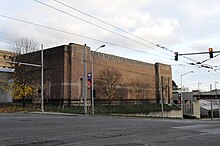Henry Art Gallery

Henry Art Gallery on the University of Washington campus
|
|
| Established | 10 February 1927 |
|---|---|
| Location |
University of Washington campus Seattle, Washington |
| Coordinates | 47°39′23″N 122°18′42″W / 47.6564°N 122.3117°W |
| Type | Art museum |
| Collection size | 25,000 |
| Founder | Horace Chapin Henry |
| Architect | Bebb and Gould (original) Gwathmey Siegel & Associates Architects (expansion) |
| Website | Henry Art Gallery |
The Henry Art Gallery ("The Henry") is the art museum of the University of Washington in Seattle, Washington, USA. Located on the west edge of the university's campus along 15th Avenue N.E. in the University District, it was founded in February, 1927, and was the first public art museum in the state of Washington. The original building was designed by Bebb and Gould. It was expanded in 1997 to 40,000 square feet (3,700 m2), at which time the 154-seat auditorium was added. The addition/expansion was designed by Gwathmey Siegel & Associates Architects.
The museum was named for Horace C. Henry, the local businessman who donated money for its founding, as well as a collection of paintings he had begun collecting in the 1890s after visiting the Chicago World's Fair. Some years prior, Henry had added gallery space to his own home on Capitol Hill, and from 1917 until the foundation of the Henry Gallery, he effectively operated a wing of his home as a free museum, open to the public 10 hours a week. In contrast to Charles and Emma Frye of Seattle's Frye Art Museum, Henry made no effort to control the future of the museum he financed; indeed, he specifically disavowed any such intention.
The Henry's exhibition program is largely devoted to contemporary art and the history of photography. Recent exhibitions include Ann Hamilton: the common S E N S E (Oct 2014), Katinka Bock: A and I (2013), Maya Lin (2006), Lynn Hershman Leeson (2005–06), Doug Aitken (2005), Axel Lieber (2004–05), and James Turrell (2003), and group exhibitions such as W.O.W. - The Work of the Work, 2004–05, which explored contemporary art's appeal to non-visual senses and the body of the viewer.
...
Wikipedia
